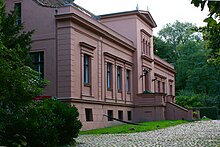Wilhelminian style museum in the Mahlsdorf manor house
The Wilhelminian style museum in the Mahlsdorf manor house was opened on August 1, 1960 by Charlotte von Mahlsdorf (alias: Lothar Berfelde). It is located on Hultschiner Damm 333 in the Berlin district of Mahlsdorf in the Marzahn-Hellersdorf district . It houses Europe's largest coherent collection of objects from the Wilhelminian era and serves as a location for film and TV productions as well as theater performances and as a registry office . The collection has been looked after by the Mahlsdorf Gutshaus Förderverein since 1997.
History of the museum
The private Gründerzeit museum was opened in 1960 by Charlotte von Mahlsdorf, who had already moved into the building two years earlier and thus saved it from demolition. The presentation at that time consisted of only two rooms, at the heyday of the exhibition there were 23! From 1974 the GDR tried to bring the private museum into state ownership. However, this project failed and the museum continued to exist after the fall of the Berlin Wall. When there was an attack by neo-Nazis during a garden party in 1991, Charlotte von Mahlsdorf decided to emigrate. Thus the museum closed in 1995. With the founding of the Gutshaus Mahlsdorf support association, the Gründerzeit museum was reopened in 1997. Since the emigration and the death of the museum's founder in 2002, the association has taken care of the maintenance, care and presentation of the collection and the building.
collection
The collection of the Wilhelminian style museum comprises 17 fully furnished exhibition rooms with furniture and everyday objects of the bourgeoisie between 1870 and 1900. These include, among other things, two women's salons, a men's room and a bedroom. There are also mechanical music machines and the oldest still preserved Zillekneipe in Berlin, the Mulackritze (around 1890).
The rooms are mostly in the neo-renaissance style, which was particularly preferred by the small and middle class. There is also a dining room in the neo-Gothic style , which was valued by the upper class. The garden hall, which was only expanded at the end of the 19th century, is furnished as a good room and is now used as a location for weddings in addition to guided tours. Since the renovation work, there has been space under the roof for various types of events. In particular, the stage play I am my own wife and (documentary) films about Charlotte von Mahlsdorf are shown regularly. The collection is also used for documentation.
In 2011 the collection that Charlotte von Mahlsdorf had rebuilt after emigrating to Sweden was purchased and has been part of the exhibition since then. Since Charlotte's death, half of the collection has belonged to the State of Berlin and the Friends' Association.
History of the manor house
The listed building was erected around 1815 as an official manor house for the Köpenick state domain . Up until the end of the First World War there were changing bourgeois owners, until it was used differently by the city of Lichtenberg from 1919 (including as a home for babies and children). The dilapidated building was supposed to be demolished at the end of the 1950s, but was saved by Charlotte von Mahlsdorf. Finally, in 1960 the Wilhelminian style museum was opened. When it reopened in 1997, the creation of a redevelopment concept began, which was adopted in 2001. In 2004, minor renovation work in line with listed buildings was started, which was followed by the renovation of the entire building from 2007 to 2012. Smaller works have been carried out to this day (as of 2019).
The conversion into the late classicist country villa , which is preserved today , began in 1869. This resulted, for example, in the large flight of stairs to the garden or the enfiladen .
park
The manor house also has a park to the south of the house. Until 1920 there was also a farmyard, which was separated at that time. The development of the landscape park took place under the last bourgeois owner of the manor house in the 80s of the 19th century.
In the mid-1990s, the park was repaired by the garden monument maintenance department of the Berlin State Monuments Office. Both the park and the courtyard area with the no longer existing farm buildings were designed in a variant similar to the state around 1900. Today the park is open to the public and can be visited. There is also a memorial stone in memory of the museum's founder Charlotte von Mahlsdorf.
literature
- Hinnerk Dreppenstedt, Klaus Esche (editor): All of Berlin - walks through the capital . Nicolaische Verlagsbuchhandlung gmbH, Berlin 2007, ISBN 978-3-89479-390-6 , p. 448.
Web links
- Video about the Wilhelminian style museum Gutshaus Mahlsdorf
- Website of the Friends of the Mahlsdorf Manor House
Individual evidence
- ↑ Gründerzeitmuseum | Charlotte. Retrieved November 22, 2019 .
- ↑ Gründerzeitmuseum | History. Retrieved November 22, 2019 .
- ↑ Gründerzeitmuseum | Collection. Retrieved November 22, 2019 .
- ↑ Gründerzeitmuseum | Founding period. Retrieved November 22, 2019 .
- ↑ Gründerzeitmuseum | History. Retrieved November 22, 2019 .
- ↑ Gründerzeitmuseum | Park. Retrieved November 22, 2019 .
Coordinates: 52 ° 30 ′ 8.7 ″ N , 13 ° 36 ′ 50 ″ E

